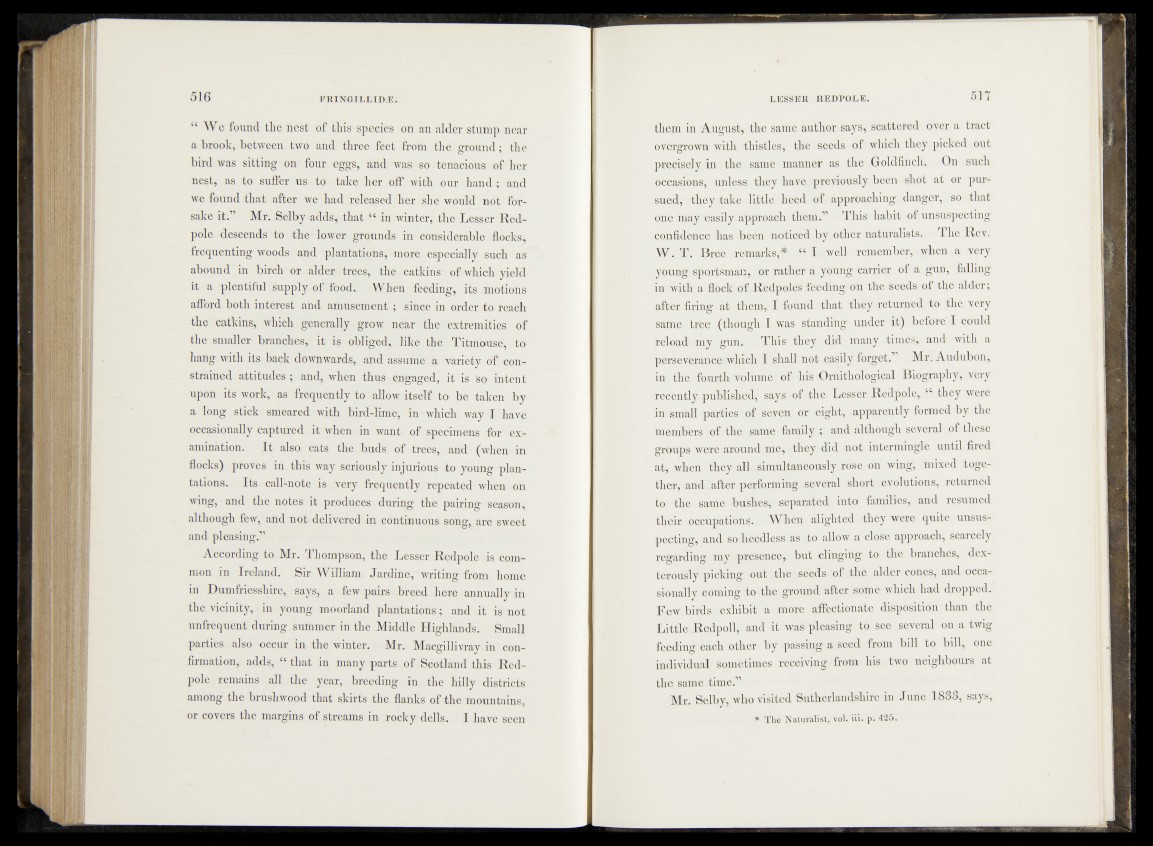
u e found the nest of this species on an alder stump near
a brook, between two and three feet from the ground; the
bird was sitting on four eggs, and was so tenacious of her
nest, as to suffer us to take her off with our hand ; and
we found that after we had released her she would not forsake
it.” Mr. Selby adds, that 44 in winter, the Lesser Red-
pole descends to the lower grounds in considerable flocks,
frequenting woods and plantations, more especially such as
abound in birch or alder trees, the catkins of which yield
it a plentiful supply of food. When feeding, its motions
afford both interest and amusement ; since in order to reach
the catkins, which generally grow near the extremities of
the smaller branches, it is obliged, like the Titmouse, to
hang with its back downwards, and assume a variety of constrained
attitudes; and, when thus engaged, it is so intent
upon its work, as frequently to allow itself to be taken by
a long stick smeared with bird-lime, in which way I have
occasionally captured it when in want of specimens for examination.
It also eats the buds of trees, and (when in
flocks) proves in this way seriously injurious to young plantations.
Its call-note is very frequently repeated when on
wing, and the notes it produces during the pairing season,
although few, and not delivered in continuous song, are sweet
and pleasing.”
According to Mr. Thompson, the Lesser Redpole is common
in Ireland. Sir William Jardine, writing from home
in Dumfriesshire, says, a few pairs breed here annually in
the vicinity, in young moorland plantations; and it is not
unfrequent during summer in the Middle Highlands. Small
parties also occur in the winter. Mr. Macgillivray in confirmation,
adds, “ that in many parts of Scotland this Red-
pole remains all the year, breeding in the hilly districts
among the brushwood that skirts the flanks of the mountains,
or covers the margins of streams in rocky dells. I have seen
LESSER REDPOLE. 5 J T
them in August, the same author says, scattered over a tract
overgrown with thistles, the seeds of which they picked out
precisely in the same manner as the Goldfinch. On such
occasions, unless they have previously been shot at or pursued,
they take little heed of approaching danger, so that
one may easily approach them.” This habit of unsuspecting
confidence has been noticed by other naturalists. The Rev.
W. T. Bree remarks,* 44 I well remember, when a very
young sportsman, or rather a young carrier of a gun, falling
in with a flock of Redpoles feeding on the seeds of the alder;
after firing at them, I found that they returned to the very
same tree (though I was standing under it) before I could
reload my gun. This they did many times, and with a
perseverance which I shall not easily forget.” Mr. Audubon,
in the fourth volume of his Ornithological Biography, very
recently published, says of the Lesser Redpole, “ they were
in small parties of seven or eight, apparently formed by the
members of the same family ; and although several of these
groups were around me, they did not intermingle until fired
at, when they all simultaneously rose on wing, mixed together,
and after performing several short evolutions, returned
to the same bushes, separated into families, and resumed
their occupations. When alighted they were quite unsuspecting,
and so heedless as to allow a close approach, scarcely
regarding my presence, but clinging to the branches, dexterously
picking out the seeds of the alder cones, and occasionally
coming to the ground after some which had dropped.
Few birds exhibit a more affectionate disposition than the
Little Redpoll, and it was pleasing to see several on a twig
feeding each other by passing a seed from bill to bill, one
individual sometimes receiving from his two neighbours at
the same time.”
Mr. Selby, who visited Sutherlandshire in June 1833, says,
* The Naturalist, vol. iii. p. 425.